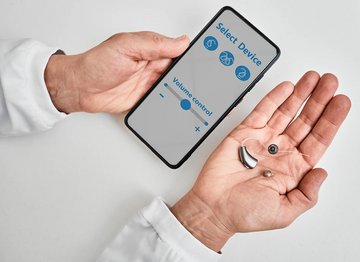If you are wondering how long a hearing test takes, you’ll be pleased to know that the whole process won’t take you more than 45-90 minutes. These easy tests measure your ability to hear different tones and understand speech. They give you a clear idea of your hearing capabilities. The results indicate the level of hearing loss and its probable cause, imparting useful information for you and your specialist to decide whether hearing assistance would prove beneficial for you.
While the precise time may vary slightly depending on your needs, this thorough evaluation provides answers more quickly than you think. Let’s take a look at what your hearing test can tell us and how it can reconnect you with sounds.
Average Duration of a Hearing Test
Let us first clarify how long the hearing test will be. Most appointments end in 45–90 minutes, with 60 minutes being average. Essential diagnostics will be conducted within this timeframe. Your first appointment will likely be 90 minutes for assessment.
Usually, it takes 60 minutes for diagnostic hearing tests. This involves consultation and primary assessment, such as tone recognition. New patients often take extra time for medical history review. Follow-ups might be shortened to 45 minutes.
Meanwhile, screenings differ significantly from full tests. Basic checks last 5–15 minutes but lack diagnostic depth. These quick checks happen at pharmacies or health fairs. A complete hearing test should always be chosen.
However, complex cases extend beyond 90 minutes. Tinnitus evaluations or balance testing add time. Children’s appointments run longer because they need engagement. Always confirm duration when scheduling.

Step-by-Step Breakdown of a Hearing Test
Let’s talk about what happens during your hearing test appointment. The procedure is to evaluate your hearing health.
Review of Medical History and Initial Consultation
The first step of your audiologic assessment is hearing concerns. The questions will deal with particular problems confronting listeners, exposure to noise, medical history, and other family experiences of hearing. Having this conversation will help tailor your hearing test. Be prepared to talk about instances when you can’t hear well.
Physical Ear Examination
The specialist will check your ears with an otoscope. The visual check takes 2-5 minutes to look for obstructions from wax, infections, and structural abnormalities. They’ll make sure your ear canals are clear before doing the actual hearing tests.
Pure Tone Audiometry
Next, you will sit in a sound booth from where you will do the “beep test.” While wearing headphones, you indicate when you hear tones of different pitches and volume levels. For 15-25 minutes, determine the sensitivity of your hearing across frequencies (your audiogram).
Speech Recognition Testing
You’ll undergo 10-15-minute speech understanding tests afterward. You would say words at different intensity levels to find your speech reception threshold. Next, you will name some one-syllable words at comfortable volumes to test clarity. These results predict real-world hearing aid benefits.
Middle Ear Evaluation
Tympanometry tests the function of the middle ear in 5-10 minutes. A small monitor alters air pressure in your ear canal as it measures eardrum movement. This test is painless. It shows if you have issues with fluid buildup or a perforated eardrum.
How to Interpret Hearing Test Results
Now that you have finished your hearing test, let’s go over exactly what those numbers and graphs mean. Your audiologist will go over the findings with you; however, understanding this information will help you ask better questions and make informed choices.
Understanding the Audiogram
First, you will see an audiogram graph. The y-axis measures volume in dB (soft and loud), while the x-axis measures pitch in Hz (low to high). The left ear is identified with blue X’s while the right ear is marked with red circles. When the marks appear lower on the chart, it means there is greater hearing loss.
Degrees of Hearing Loss
Next, the results fall under different ranks.
Sound bounces back correctly, but not outside the normal range.
Mild loss (26-40 dB) – misses soft sounds.
Moderate hearing loss (41-55 dB) - Cannot follow normal speech
Moderately-severe (56-70 dB) - misses most conversations.
Hears only loud sound – Severe (71-90 dB).
Deafness that may rely on vision; 91+ dB.
Speech Understanding Scores
After that, your word recognition score, which is usually a percentage, shows how well you make sense of speech when the volume is loud enough. Exceeding 90% is excellent, 70 to 89% means some trouble, but falling below 70% indicates significant issues, even with amplification.
Type of Hearing Loss
Also, your results will indicate if the loss is:
Sensorineural. Damage to the inner ear (most common)
In the outer or middle ear (often treatable)
Mixed (combination of both)
Do keep in mind that your audiologist will explain how these results affect your life. They will recommend the next steps, whether it be monitoring, medical referral, or an appropriate hearing aid discussion. Always ask as many questions as you wish until you understand your hearing profile.
When to Consider Hearing Aids
The test results provide you with a clear picture of your hearing condition. But then, many people have a common question: if the test shows hearing loss, do I need to wear hearing aids? In fact, the need for best otc hearing aids depends not only on the test results but also on how much your hearing affects your daily life.
Communication Struggles
Do you often ask someone to repeat what they said? If “What?If “pardon,” or “excuse me” has become your most-used word in conversations, especially with background noise, it’s a clear signal. Missing parts of family get-togethers or work meetings signal that your ears can’t keep up anymore.
Social Withdrawal
See if you’ve started to avoid social situations you enjoyed before. Many people skip events without even realizing, as listening is too much work. Are you turning down dinner invites and leaving parties early because of hearing fatigue? Hearing aids may help you reconnect.
Volume Adjustments
Additionally, check your device habits. Are you maxing out the TV volume despite complaints? Is the phone volume not satisfactory enough to help you hear clearly? If your hearing is no longer up to par with everyday demands, take these practical signs to heart.
Safety Concerns
Moreover, consider your environmental awareness. Failing to hear alarms, doorbells, or horns can be dangerous. In case you have close encounters, as you were unable to hear warnings or sounds, then with hearing aids, you can receive warnings and sounds to aid in your safety.
Professional Recommendation
Finally, your audiologist’s advice matters most. If your test shows mid-level hearing loss, especially with poor speech comprehension, they probably will recommend OTC hearing aids. Even mild loss with certain lifestyle challenges may need amplification.
There’s no “perfect” time to embark on this journey. The sooner you start, the easier it will be to adjust to your hearing aids. Today’s devices are inconspicuous, comfortable, and more advanced than you remember from years ago.

Recommended Hearing Aids for Different Needs
Devices like Linner can help whether your hearing loss is mild or severe. We will match you with the model that best fits your lifestyle and hearing needs.
Mild or Moderate Hearing Loss
Linner Mars
The Linner Mars is the perfect suit for tech experts and Bluetooth fans. Next, its four-microphone Focus Mode targets speech in front of you and suppresses background noise. Next, you can personalize settings, like volume, modes, and tinnitus therapy, using the LINNER HA App. Subsequently, it will intensify sound by 45dB. Great for streaming calls/music, active lifestyles, or tinnitus.
Linner Saturn Series
On the other hand, Linner Saturn is discreet and simple. First, its CIC hearing aids design sits deep in the ear canal, making it almost invisible. The speaker produces clear sound with a gain of 30 dB, so it fits moderate loss cases. Then, it has a 20-hour battery life, which is ideal for all-day wear without needing to recharge. Also, at $85, it is one of the cheapest OTC options. Bluetooth is not available, but it is suitable for first-time users for comfort.
Choose Mars for feature-rich versatility; opt for Saturn for simplicity and value. Both are suitable for mild to moderate hearing loss and include 45-day trials and HSA/FSA eligibility.
Severe Hearing Loss
Linner mercury
The Linner Mercury is the best RIC hearing aid by LINNER, designed for users with mild to profound hearing loss who need reliable, high-performance sound all day. It's nearly invisible receiver-in-canal (RIC) design features 16-channel WDRC and the original ONSEMI™ Chip (USA) for clear, precise audio. Advanced noise reduction technology ensures optimal listening in any environment, while a full 2-hour charge provides up to 20 hours of battery life. It also comes with a portable charging case, keeping you connected without disruption
Conclusion
Wondering how long a hearing test takes? You will be pleased to know this important health test only requires 45-90 minutes of your time. At this successful visit, your hearing expert will.
Go through your hearing history and issues.
Look for physical obstructions in your ear.
Check how you respond to a variety of tones and speech patterns.
These simple tests tell you what sounds you are missing and why. The test results will tell if you have mild, moderate, or greater hearing loss, and also whether it is sensorineural (inner ear) or conductive (mechanical).
Today’s solutions for hearing loss, like the Linner Mars (with Bluetooth) or Linner Saturn (for comfort), are easier than ever to find. When it comes to treatments of any kind, early detection usually helps yield better results. As such, knowing how long a hearing test takes is the first step towards maintaining one’s connection to different sounds of life that matter the most.
Read more:







![Linner Mercury Clarity OTC Hearing Aids [FSA & HSA Eligible] Linner](http://www.linnerlife.com/cdn/shop/files/Linner-Mercury-Clarity-OTC-Hearing-Aids-_FSA-_-HSA-Eligible_-Linner-110038953.webp?v=1725853434&width=360)
![Linner Saturn OTC 補聴器 [FSA および HSA 対象]](http://www.linnerlife.com/cdn/shop/files/Saturn_2_muse_black.webp?v=1756780425&width=360)
![Linner Mars OTC Hearing Aids [FSA & HSA Eligible] Linner](http://www.linnerlife.com/cdn/shop/files/Linner-Mars-OTC-Hearing-Aids-_FSA-_-HSA-Eligible_-Linner-110039213.webp?v=1725865495&width=360)
